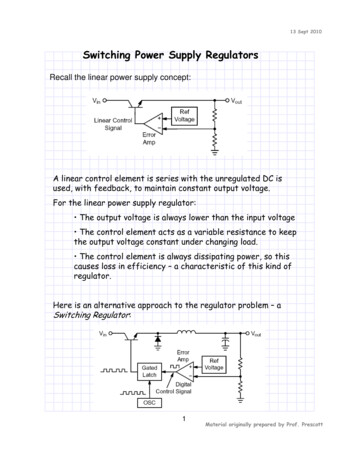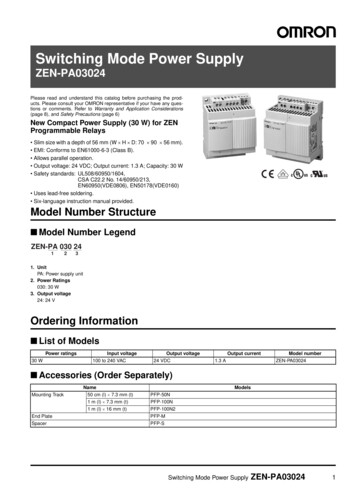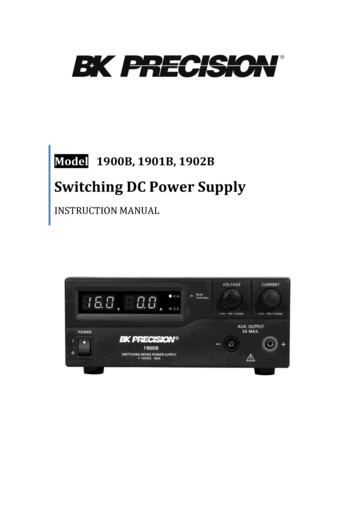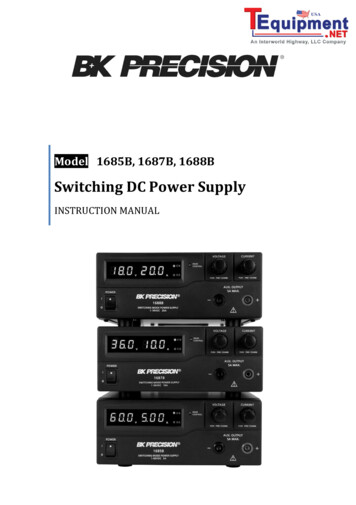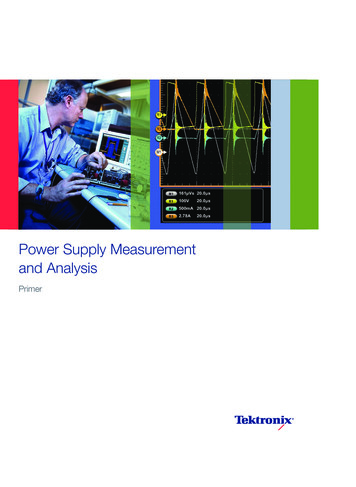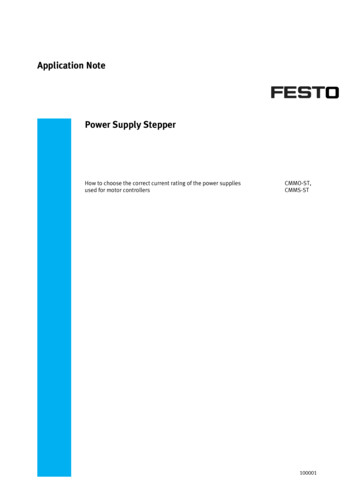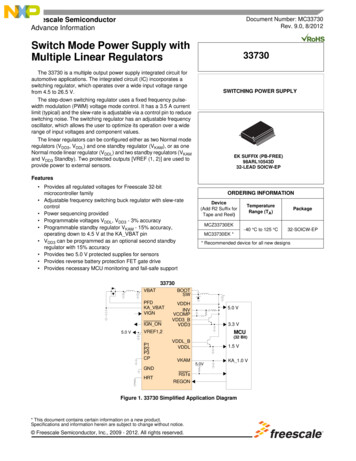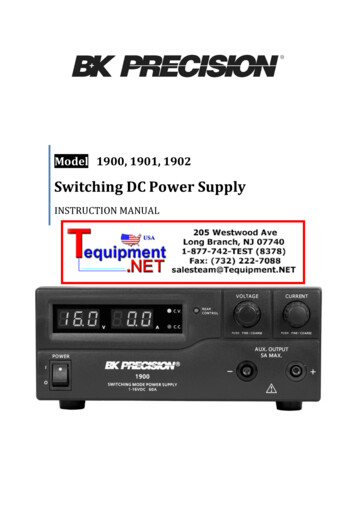
Transcription
Model 1900, 1901, 1902Switching DC Power SupplyINSTRUCTION MANUAL
1Safety SummaryThe following safety precautions apply to both operating and maintenance personnel andmust be observed during all phases of operation, service, and repair of this instrument. Beforeapplying power, follow the installation instructions and become familiar with the operatinginstructions for this instrument.GROUND THE INSTRUMENTTo minimize shock hazard, the instrument chassis and cabinet must be connected toan electrical ground. This instrument is grounded through the ground conductor ofthe supplied, three-conductor ac power cable. The power cable must be pluggedinto an approved three-conductor electrical outlet. Do not alter the groundconnection. Without the protective ground connection, all accessible conductiveparts (including control knobs) can render an electric shock. The power jack andmating plug of the power cable meet IEC safety standards.DO NOT OPERATE IN AN EXPLOSIVE ATMOSPHEREDo not operate the instrument in the presence of flammable gases or fumes.Operation of any electrical instrument in such an environment constitutes a definitesafety hazard.KEEP AWAY FROM LIVE CIRCUITSInstrument covers must not be removed by operating personnel. Componentreplacement and internal adjustments must be made by qualified maintenancepersonnel. Disconnect the power cord before removing the instrument covers andreplacing components. Under certain conditions, even with the power cableremoved, dangerous voltages may exist. To avoid injuries, always disconnect powerand discharge circuits before touching them.DO NOT SERVICE OR ADJUST ALONEDo not attempt any internal service or adjustment unless another person, capable ofrendering first aid and resuscitation, is present.DO NOT SUBSTITUTE PARTS OR MODIFY THE INSTRUMENTDo not install substitute parts or perform any unauthorized modifications to thisinstrument. Return the instrument to B&K Precision for service and repair to ensurethat safety features are maintained.1
WARNINGS AND CAUTIONSWARNING and CAUTION statements, such as the following examples, denote ahazard and appear throughout this manual. Follow all instructions contained inthese statements.A WARNING statement calls attention to an operating procedure, practice, orcondition, which, if not followed correctly, could result in injury or death topersonnel.A CAUTION statement calls attention to an operating procedure, practice, orcondition, which, if not followed correctly, could result in damage to or destructionof parts or the entire product.WARNING:Do not alter the ground connection. Without the protective groundconnection, all accessible conductive parts (including control knobs)can render an electric shock. The power jack and mating plug of thepower cable meet IEC safety standards.WARNING:To avoid electrical shock hazard, disconnect power cord beforeremoving covers. Refer servicing to qualified personnel.CAUTION:Before connecting the line cord to the AC mains, check the rear panelAC line voltage indicator. Applying a line voltage other than theindicated voltage can destroy the AC line fuses. For continued fireprotection, replace fuses only with those of the specified voltage andcurrent ratings.CAUTION:This product uses components which can be damaged by electrostatic discharge (ESD). To avoid damage, be sure to follow properprocedures for handling, storing and transporting parts andsubassemblies which contain ESD-sensitive components.SAFETY SYMBOLSThis symbol on an instrument indicates that the user should refer to theoperating instructions located in the manual.CertificationWe certify that this product met its published specifications at time of shipment from thefactory.2
Compliance StatementsDisposal of Old Electrical & Electronic Equipment (Applicable in the European Union andother European countries with separate collection systems)This product is subject to Directive 2002/96/EC of the EuropeanParliament and the Council of the European Union on wasteelectrical and electronic equipment (WEEE), and in jurisdictionsadopting that Directive, is marked as being put on the marketafter August 13, 2005, and should not be disposed of asunsorted municipal waste. Please utilize your local WEEEcollection facilities in the disposition of this product andotherwise observe all applicable requirements.3
Contents123456789Safety Summary . 1Introduction . 5Controls and Indicators . 63.1Front Panel . 63.2Rear Panel . 7Operating Instructions . 84.1Using the Power Supply . 94.1.1Connection . 94.1.2Self Test Sequence . 94.1.3Control Knobs. 114.1.4Using Both Main and Auxiliary Outputs . 124.2Control Modes . 124.2.1Normal Mode . 134.2.2Preset Mode . 134.2.3Set Mode . 144.2.4Remote Control Mode . 154.3Remote Sensing. 154.3.1Connection . 154.3.2Disconnection. 164.4Remote Control . 164.4.1Voltage Remote Control. 164.4.2Enable and Disable the Output . 20Faults and Troubleshooting . 215.1OVP: Overvoltage Protection . 215.2OTP: Overtemperature Protection. 225.3OLP: Overload Protection. 225.4Fuse Replacement . 23Specifications . 24Certification . 26Service Information . 27Limited Two-Year Warranty . 284
2IntroductionB&K Precision models 1900, 1901, and 1902 are laboratory grade switching mode DCpower supplies with high current output in a small form factor and lightweightpackage. The 1900 Series provide different configurations of high output voltage orhigh output current and make setting voltage and current levels fast and precisethrough its dual action, course/fine rotary encoder control. In addition to its constantvoltage (CV) and constant current (CC) modes, the high efficiency DC power supplyoffers a unique solution with its preset and analog remote control modes. Save up tothree different presets of voltage and current values for quick recall. The analogremote control function allows the output power, voltage, and current to be adjustedwithout touching the front panel of the power supply. A remote sensing terminal(model 1900 only) is also available for use to compensate for voltage drop acrossload leads. These features make the 1900 Series suitable for a wide range ofapplications including production testing, telecommunications, R&D, service, anduniversity labs.Features Automatic CV/CC crossover operation Up to 60 A output current Lightweight and compact Rotary encoder control for precise voltage and current setting 3 user-defined voltage and current presets Analog remote control function Remote sensing terminal (model 1900 only) Overvoltage, overtemperature, and overload protection Front panel auxiliary output5
3Controls and Indicators3.1Front PanelFigure 1 - Front Panel(1)LED panel meter display with CV/CC indicator(2)Rear Control Indicator (lights up when using Preset/Remote Control/Set mode)(3)Output Voltage Control Knob (control main and auxiliary output voltage)(4)Output Current Control Knob (control main and auxiliary output current limit)(5)Power ON/OFF Switch(6)Auxiliary Output Terminal (max 5 A)Note:Please see Section 4.1.4 for more details on using both main andauxiliary output terminals together.6
3.2Rear PanelFigure 2 - Rear Panel(7)Main Output Terminal (max 60 A for 1900 / 30 A for 1901 / 15 A for 1902)Note:Please see Section 4.1.4 for more details on using both main andauxiliary output terminals together.(8)Remote Sensing Terminal (model 1900 only)(9)Mode Selection Switch (Normal, Preset, Remote Control, Set Modes)(10)Recall Preset Selection Switch(11)Analog Remote Control Terminal(12)Cooling Fan Air Intake Grille(13)AC Input Plug and Fuse Compartment7
4Operating InstructionsSafety Precautions Never short the remote sensing terminal. This power supply is for indoor use only. Do not expose the power supply to sun, high humidity, or dustyenvironments. Never remove the metal cover of the power supply while AC power isconnected. Never touch the unit when your hands are wet. Never block the ventilation slots and cooling fan air intake window. Never attempt to repair the power supply. Incorrect re-assembly mayresult in a risk of electric shock or fire. Never use the power supply for a load requiring higher current than thedesigned value. Otherwise it may damage the power supply. Place the power supply on a flat surface with sufficient clearance and dry,dust-free surroundings for ventilation.This series has three models with different output voltage and current ranges. Makesure you have purchased the correct one.Model NumberOutput Voltage RangeTotal Rated Current19001 – 16 V0 – 60 A19011 – 32 V0 – 30 A19021 – 60 V0 – 15 ATable 1 - Model Table8
4.1Using the Power Supply4.1.1ConnectionTo connect the equipment to the power supply, follow the steps below.1. Check the rating label of the power supply and confirm that it complies withyour AC mains voltage.2. Connect the power supply to the AC mains using the provided power cordand make sure the Mode Selection Switch is in the Normal position.3. Hook up the red ( ) terminal to the positive polarity input of the equipmentand the black (-) terminal to the negative polarity input of the equipment.4. Switch on the power supply first. The panel meter and green CV indicatorshould light up again.5. Switch on the equipment. The panel meter and green CV indicator shouldstill remain green.6. When an operation is finished, switch off the equipment first and thenswitch off the power supply.4.1.2Self Test SequenceThe power supply will perform a series of self checks when it is switched on. Thetable below shows the self test sequence.Front Panel DisplayTestTo show software version9
Front Panel DisplayTestSegment checkC.V. indicator checkC.C. indicator checkRear control indicatorcheckReturn to C.V.Start power supply checksOvervoltage protectioncheckOverload protection check10
Front Panel DisplayTestOvertemperatureprotection checkFan checkOutput off (remotecontrol mode)Table 2 - Self Test SequenceThe LED and other indicators on the front panel will be turned on. When the coolingfan is being checked, a loud fan noise can be heard.After the self checks, the CV, V, and A LED indicators are lit up displaying voltage and0.0 current. To find out about the set CC current level, just turn the current controlknob one click in either direction. The current display returns to 0.0 after a fewseconds.4.1.3Control KnobsThe rotary encoder control knobs have fine and coarse tuning with clickingmovement.Push the knobs to toggle between coarse and fine tuning. You will notice the subtlechange in brightness of LED.Adjust the knobs to your desired values through coarse and fine tuning. The displaywill resume its normal brightness after a few seconds to confirm your adjustment.11
4.1.4Using Both Main and Auxiliary OutputsThe power supply has a main output in the rear and an auxiliary output in the frontthat can be used separately or together.The main and auxiliary output both share the same voltage and current control knobsand will output the same voltage and current up to the maximum output ratings ofthe power supply and terminals. When using both the main and auxiliary outputstogether, the power supply will automatically total the currents supplied to bothterminals up to the current limit of the power supply and show the total current onthe display.For example, setting the voltage and current outputs for model 1900 (1-16 V, 0-60 A)to 16 V and 60 A would output 16 V at both main and auxiliary terminals and allowyou to draw up to a total of 60 A between the two terminals. If there is a 5 A load atthe auxiliary terminal, the most current you can draw from the main output is 55 A.If the power supply reaches its set current limit at any time, the power supply will gointo CC mode and the loads together will draw up to the total value of the currentlimit. Distribution of current between the main and auxiliary terminals will varydepending on the loads.Note:4.21900: Total rated current (Aux. Main) is 60 A1901: Total rated current (Aux. Main) is 30 A1902: Total rated current (Aux. Main) is 15 AControl ModesThere are four different control modes for the power supply: NormalPresetSetRemote ControlTo select a mode, slide the Mode Selection Switch on the rear of the unit.12
Note:4.2.1The power supply is factory preset to Normal Mode with maximumcurrent level.Normal ModeThis is the factory preset mode and the power supply output voltage and current arecontrolled by the dual action dial knobs.Push the knobs to toggle the coarse and fine tuning. You will notice the subtlechange in brightness of LED.Adjust the knobs to your desired values through coarse and fine tuning. To check thepreset current level, turn the Current Knob lightly in any direction.The display will resume its normal brightness after a few seconds to confirm youradjustment.4.2.2Preset ModeIn this mode, the Rear Control light is ON to indicate panel voltage and currentcontrols are deactivated.There are three presets P1/P2/P3 on the Recall Selection Switch. The factory presetvalues are shown in Table 3.The user can also set their own output voltage and current using Set Mode. Pleaserefer to Section 4.2.3 for details.Recall No.Output VoltageOutput CurrentP15VMaximumP213.8 VMaximumP3Model 1900: 15 VModel 1901: 25 VModel 1902: 55 VMaximumTable 3 - Default Presets13
4.2.3Set ModeFirst, enter Set Mode by pushing Mode Selection Switch to “Set” position.To define the preset output P1/P2/P31. Select the Recall Switch to the position you want to set: P1, P2, or P3.2. Adjust the front panel voltage control knob to set your desired voltagevalue.3. Adjust the front panel current control knob to set your desired current limitvalue.4. Repeat the procedure for remaining presets P1, P2, or P3 if desired.5. Move Mode Selection Switch from “Set” to “Preset” position to confirm yoursettings.To reset the unit back to factory settings1. Turn OFF the power supply.2. Push and hold both front panel voltage and current control knobs at thesame time.3. Turn ON the power supply.4. Release front panel voltage and current control knobs.Note: All the set values in the presets will be saved even after the power supplyhas been turned off.Always check output voltage of Presets before connecting to load.To check the preset values, move Mode Selection Switch to “Preset”position.Move the Recall Switch to P1, P2, or P3.The voltage and current settings of corresponding presets P1, P2, or P3 willbe shown on the panel meters.14
4.2.4Analog Remote Control ModeSelect this mode to control the output voltage and current by Remote ControlConnector. Please refer to Section 4.4 for more details.4.3Remote Sensing(Model 1900 Only)WARNING: Never short the remote sensing terminal.Never connect the remote sensing terminal in reverse polarity.Always disconnect the remote sensing terminal first after use.4.3.1Connection1. Make the power connections between power supply and equipment.2. Check and make sure the power connections are secure.3. Then make connections between Remote Sense Terminal and equipment.Figure 3 shows typical connection between power supply and device for remotesense operation.Figure 3 - Remote Sense ConnectionThe remote sensing wire gauge should be at least 22AWG.15
4.3.2DisconnectionWARNING: Wrong disconnect sequence will damage the power supply.1. Disconnect the remote sensing connections.2. Disconnect the power connections between the power supply andequipment.4.4Analog Remote ControlThere are two methods to remote control voltage and current.Note: Both methods require the remote control connector plug to be set up in orderfor analog remote control mode to be functional; otherwise the unit will be in CCmode all the time.4.4.1Voltage Remote ControlSet up the provided remote connector plug.(a)Remove the black portion of the remote control connector plug by removingthe screw as shown in Figure 4.Figure 4 - Remote Control Connector(b)Solder 5 wires (22AWG) to pins 1, 2, 3, 4, and 5 of pin plug. Refer to Figure 5for pin numbers.16
Figure 5 - Pin Numbers(c)Make sure the load is disconnected and the power supply is OFF.(d)Plug the remote connector plug into the analog remote control terminal of thepower supply.(e)Secure the remote connector plug to the terminal socket by locking theconnector ring (Figure 6).Figure 6 - Connector RingThen, you can choose either method A or B below to use the analog remote controlfeature.17
Method A: Using Two External Variable DC Voltage SourcesPINFUNCTIONSREMARKS1Internal DC 5 VLess than 50 mA2Voltage Adjust0–5V3Current Adjust0–5V4Ground5Output OFF6N/A7N/A8N/AShort to GroundTable 4 – Remote Connector Plug Pin Assignment for External Variable Voltage SourcesA variable external DC voltage source of 0 – 5 V is fed into the analog remote controlterminal to adjust the output voltage level of both Main and Auxiliary output.WARNING: Do not input higher than 5 V, otherwise the overvoltage protection(OVP) will be triggered.1. Make sure the load is disconnected and the power supply is OFF.2. Connect pin 2 to positive polarity of first external voltage source and pin 4 tonegative polarity of first external voltage source.3. Connect pin 3 to positive polarity of second external voltage source and pin4 to negative polarity of second external voltage source.4. Turn the remote control ON/OFF switch to ON position.18
5. Switch on the power supply.6. Check the output voltage range of the power supply by varying the externalvoltage source for voltage adjustment from 0 to 5 V.7. Short circuit the main output with an 8AWG gauge wire and check thedisplay for CC setting by varying the external voltage source for currentadjustment from 0 to 5 V.8. Switch off the power supply.Method B: Using Two 5 kΩ Variable Resistors1. Make sure the load is disconnected and the power supply is OFF.2. Prepare two 5 kΩ variable resistors and connect wires from pins 1, 2, 3, and4 as shown in Figure 7.Figure 7 - Variable 5 kΩ Resistors Setup19
PINFUNCTIONSREMARKS1Internal DC 5 VResistor end2Voltage AdjustVariable part of resistor3Current AdjustVariable part of resistor4GroundResistor end5Output OFFShort to Ground6N/A7N/A8N/ATable 5 – Remote Connector Plug Pin Assignment for Variable Resistors3. Turn the remote control ON/OFF switch to ON position.4. Switch on the power supply.5. Check the output voltage range of the power supply by varying the 5 kΩvariable resistor for voltage adjustment.6. Short circuit the main output with 8AWG gauge wire and check the displayfor CC setting by varying the 5 kΩ variable resistor for current adjustment.7. Switch off the power supply.4.4.2Enable and Disable the OutputThis remote output on/off control can be activated in any of the modes.By default, Pin 5 is open and output is on.20
Shorting Pin 5 to Pin 4 (ground) will turn the output off.When output is off, the CV and CC LED will flash. The current output voltage andcurrent setting will show on the panel meter.You can also adjust the output by voltage and current control knob to your desiredvalue when output is off.5Faults and Troubleshooting5.1OVP: Overvoltage ProtectionThis unit has a built-in tracking overvoltage protection feature. In the event of theoutput voltage becoming greater than the set value (see specified range from“Specifications”), protection will be triggered and the output power will be cut off.OVP warning will appear as shown below.Figure 8 - Overvoltage ProtectionTo reset the warning, switch off the unit and remove all connected devices. Switchthe unit back on again and it should resume normal operation. If the problempersists, please contact B&K Precision.21
5.2OTP: Overtemperature ProtectionThere is a thermo sensor inside the unit to monitor and prevent the unit from gettingtoo hot. When OTP is triggered, there is no output and the following warning willappear on the LED display.Figure 9 - Overtemperature ProtectionWhen you get this warning, switch off the unit and remove all loading. Check yourload and output settings and allow the unit to cool down for at least 30 minutes.Check if any of the ventilation is blocked and make sure there is enough clearancearound the power supply. Listen carefully for the fan noise from the cooling fan whenyou turn on the unit again. If you cannot hear this routine self test fan noise uponpower on, the fan has failed and the power supply should not be used. In this case,please contact B&K Precision.5.3OLP: Overload ProtectionNormally the overload protection is sustained by the CC constant current mode.When the CC mode fails and goes undetected, it may cause serious damage to yourtest piece or load. The OLP is to minimize the extent of damage to your loads aspower supplies will fail at some point in time. Switch off your power supply as soonas you see this warning as shown below.22
Figure 10 - Overload ProtectionTo reset this warning, switch off the unit and remove all connected devices. Switchthe unit back on again and double check with caution. If the problem persists, pleasecontact B&K Precision.5.4Fuse ReplacementIf the fuse blows, the CV or CC indicators will not light and the power supply will notoperate. The fuse should not normally open unless a problem has developed in theunit. Try to determine and correct the cause of the blown fuse, then replace onlywith a fuse of the correct rating as listed below. The fuse is located on the rear panel(see Figure 2). Pull fuse compartment out with a flathead screwdriver and replacefuse in holder.Line VoltageFuseType100 – 120 VAC12 A/250 V20mm standard glass tube fast blow220 – 240 VAC8 A/250 V20mm standard glass tube fast blowTable 6 - Fuse Table23
6SpecificationsModels190019011902Variable Output Voltage1 – 16 V1 – 32 V1 – 60 VVariable Output Current0 – 60 A0 – 30 A0 – 15 AOutputAuxiliary Output Current5AVoltage RegulationLoad (0-100% Load) 50 mVLine (90-132 VAC, 170-264VAC Variation) 20 mVCurrent RegulationLoad (10-90% Rated Voltage) 200 mALine (90-132 VAC, 170-264VAC Variation) 150 mA 100 mA 50 mARipple & NoiseRipple & Noise Voltage (rms) 5 mVRipple & Noise Voltage(peak-peak) 50 mV 50 mV 100 mVCurrent Ripple & Noise (rms) 100 mA 50 mA (120 VAC) 40 mA (230 VAC) 15 mAMeter Type & AccuracyVoltage Meter3-Digit LED Display 0.2% 3 countsCurrent Meter3-Digit LED Display 0.2% 3 countsOtherInput Voltage120 VAC 50 Hz, 230 VAC 60 Hz (request on order*)Full Load Input Current9.4 A (120 VAC)4.7 A (230 VAC)9.0 A (120 VAC)4.5 A (230 VAC)9.3 A (120 VAC)4.5 A (230 VAC)Efficiency84% (120 VAC)85% (230 VAC)87% (120 VAC)86% (230 VAC)87% (120 VAC)88% (230 VAC)24
Models190019011902Switching Frequency65 – 85 kHz75 – 95 kHz65 – 85 kHzTracking OvervoltageProtectionsO/P 1-5 V: setvoltage 2 VO/P 5-16 V: setvoltage 3 VO/P 1-5 V: setvoltage 2 VO/P 5-20 V: setvoltage 3 VO/P 20-32 V: setvoltage 4 VO/P 1-5 V: setvoltage 2 VO/P 5-20 V: setvoltage 3 VO/P 20-60 V: setvoltage 4 VTransient Response Time(50-100% Load)1.5 msPower Factor Correction 0.95 at optimal loadCooling MethodProtectionsSpecial FeaturesThermostatically controlled fan from zero to full speedOverload, Short Circuit by Constant Current,Overvoltage, Overtemperature3 User-Defined Voltage and Current Presets, AnalogRemote Control, Remote Sensing (model 1900 only)Operating Temperature32 F to 104 F (0 C to 40 C) 80% R.H.Storage Temperature5 F to 158 F (-15 C to 70 C) 85% R.H.Dimensions (WxHxD)7.9” x 3.5” x 10.8” (200 x 90 x 275 mm)WeightSupplied Accessories7 lbs (3.2 kg)Power cord, instruction manual, remote controlconnectorNote: All specifications apply to the unit after a temperature stabilization time of 15minutes over an ambient temperature range of 23 C 5 C. Specifications aresubject to change without notice.*For 230 V version, request EXD model on order: 1900EXD, 1901EXD, or 1902EXD.To ensure the most current version of this manual, please download the latestversion here: http://www.bkprecision.com/search/manual/1902For current up-to-date product information, please visit www.bkprecision.com25
7CertificationCE CompliantCE Declaration of ConformityThe power supply meets the requirements of 2006/95/EC Low Voltage Directive and2004/108/EC Electromagnetic Compatibility Directive.Low Voltage Directive- EN 60950- EN 61010o Safety requirements for electrical equipment for measurement,control, and laboratory use.EMC Directive- EN 55011- EN 55022o Electrical equipment for measurement, control, and laboratory use.26
8Service InformationWarranty Service: Please go to the support and service section on our website atwww.bkprecision.com to obtain an RMA #. Return the product in the originalpackaging with proof of purchase to the address below. Clearly state on the RMA theperformance problem and return any leads, probes, connectors, and accessories thatyou are using with the device.Non-Warranty Service: Please go to the support and service section on our websiteat www.bkprecision.com to obtain an RMA #. Return the product in the originalpackaging to the address below. Clearly state on the RMA the performance problemand return any leads, probes, connectors, and accessories that you are using with thedevice. Customers not on an open account must include payment in the form of amoney order or credit card. For the most current repair charges, please refer to theservice and support section on our website.Return all merchandise to B&K Precision Corp. with pre-paid shipping. The flat-raterepair charge for Non-Warranty Service does not include return shipping. Returnshipping to locations in North America is included for Warranty Service. For overnightshipments and non-North American shipping fees, please contact B&K PrecisionCorp.B&K Precision Corp.22820 Savi Ranch ParkwayYorba Linda, CA 92887www.bkprecision.com714-921-9095Include with the returned instrument your complete return shipping address,contact name, phone number, and description of problem.27
9Limited Two-Year WarrantyB&K Precision Corp. warrants to the original purchaser that its products and thecomponent parts thereof will be free from defects in workmanship and materials, fora period of two years from date of purchase.B&K Precision Corp. will, without charge, repair or replace, at its option, defectiveproduct or component parts. Returned product must be accompanied by proof of thepurchase date in the form of a sales receipt.To obtain warranty coverage in the U.S.A., this product must be registered bycompleting a warranty registration form on our website www.bkprecision.com withinfifteen (15) days of purchase.Exclusions: This warranty does not apply in the event of misuse or abuse of theproduct or as a result of unauthorized alterations or repairs. The warranty is void ifthe serial number is altered, defaced, or removed.B&K Precision Corp. shall not be liable for any consequential damages, includingwithout limitation, damages resulting from loss of use. Some states do not allowlimitations of incidental or consequential damages. So the above limitation orexclusion may not apply to you.This warranty gives you specific rights and you may have other rights, which varyfrom state-to-state.B&K Precision Corp.22820 Savi Ranch ParkwayYorba Linda, CA 92887www.bkprecision.com714-921-909528
(Page intentionally left blank)
22820 Savi Ranch ParkwayYorba Linda, CA 92887www.bkprecision.com 2011 B&K Precision Corp.Printed in Hong Kongv041211
To connect the equipment to the power supply, follow the steps below. 1. Check the rating label of the power supply and confirm that it complies with your AC mains voltage. 2. Connect the power supply to the AC mains using the provided power cord and make sur

